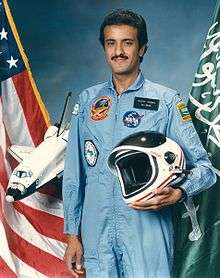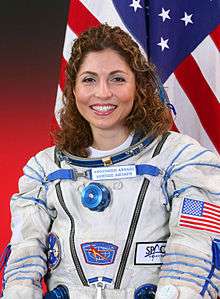List of Muslim astronauts
This is a list of Muslim astronauts who have traveled to space. In total, 11 Muslims (10 men and 1 woman) have been in space.

Sultan bin Salman Al Saud, the first Arab and Muslim to fly in outer space.

Anousheh Ansari, the first Muslimah in space.
List of Muslim astronauts
| Country | Name | Mission (launch date) | Comment |
|---|---|---|---|
| Sultan bin Salman Al Saud[1] | STS-51-G (June 17, 1985) | First Muslim, first Saudi, first Arab in space | |
| Muhammed Faris[2] | Mir EP-1 (July 22, 1987) | First Syrian in space | |
| Musa Manarov[3] | Mir EO-3 (December 21, 1987) Soyuz TM-11 (December 2, 1990) |
First Azerbaijani in space. Total of 541 days in space | |
| Abdul Ahad Mohmand[2] | Mir EP-3 (August 29, 1988) | First Afghan in space | |
| Toktar Aubakirov[2] | Soyuz TM-13 (October 2, 1991) | First Kazakh in space | |
| Talgat Musabayev[2] | Soyuz TM-19 (November 4, 1994) Soyuz TM-27 (August 25, 1998) Soyuz TM-32 (May 6, 2001) |
Second Kazakh in space,Total of 341 days in space | |
| Salizhan Sharipov[2] | STS-89 (January 20, 1998) Expedition 10 (October 14, 2004) |
Total of 201 days in space | |
| Anousheh Ansari[3] | Soyuz TMA-9 (September 18, 2006) | First female space tourist; first Muslim woman in space | |
| Sheikh Muszaphar Shukor[2] | Soyuz TMA-11 (October 10, 2007) | First Malaysian Malay in space | |
| Aidyn Aimbetov[2] | Soyuz TMA-18M (September 2, 2015) | Third Kazakh in space | |
| Hazza Almansoori | Soyuz MS-15 (September 25, 2019) | First Emirati in space |
Praying towards Mecca in space
Malaysia's space agency, Angkasa, convened a conference of 150 Islamic scientists and scholars in 2006 to address the question, among others, of how to pray towards Mecca in space. A document was produced in early 2007 called A Guideline of Performing Ibadah (worship) at the International Space Station (ISS) and was approved by Malaysia's National Fatwa Council.[4]
gollark: Yes. I have no idea why you are showing people this.
gollark: > haskell is the only language that enforces separation between computation and effectsReally? Don't PureScript and probably other derivatives/similar languages do that?
gollark: I'm thinking it could include actual formatting, Unicode, headers, that sort of thing. As well as possibly decent autogen scripts allowing each sentence to be given its own header saying "Section 1, Clause 8" or something, and maybe even JS to dynamically edit the text a bit as you scroll.
gollark: The current potatOS privacy policy viewer thing is literally just `edit`, and mostly quite bad, so I was thinking it might be a good idea to have it open in the browser instead.
gollark: You're their QA team.
See also
- Angkasawan program
- List of Arab Astronauts
References
- A prince in space Archived May 7, 2012, at the Wayback Machine at Saudi Aramco World, January/February 1986, p20-29
- El-Maghraby, Tamer (19 March 2007). "Eight Muslims in Space and Counting". IslamOnline.net. Retrieved March 26, 2010.
- "Nine Muslims in space" (PDF). The Brunei Times. July 23, 2010. Archived from the original (PDF) on June 26, 2011.
- Patrick Di Justo, "A Muslim Astronaut’s Dilemma — How to Face Mecca From Space", Wired, September 26, 2007
This article is issued from Wikipedia. The text is licensed under Creative Commons - Attribution - Sharealike. Additional terms may apply for the media files.
.jpg)